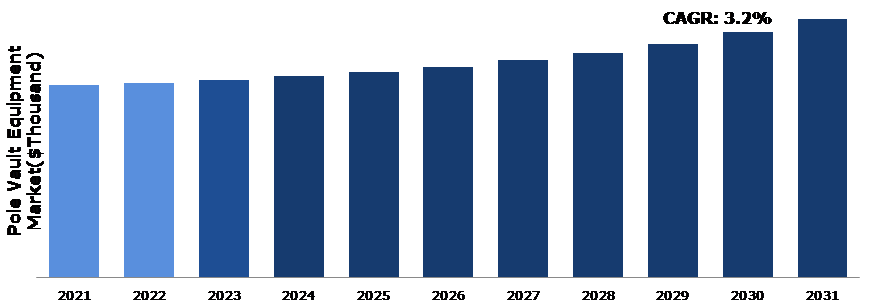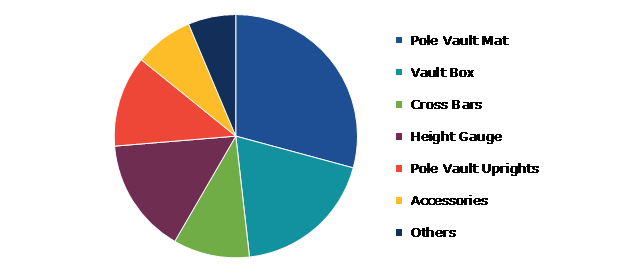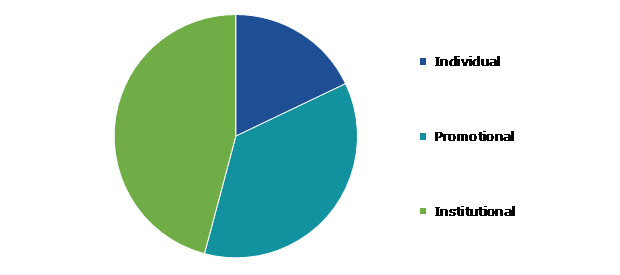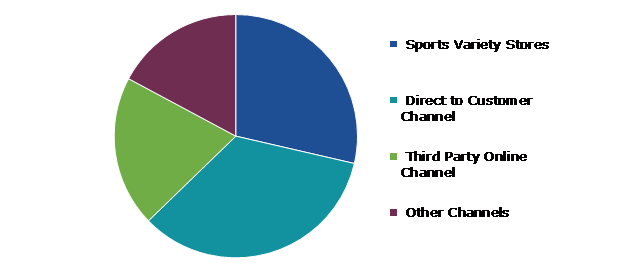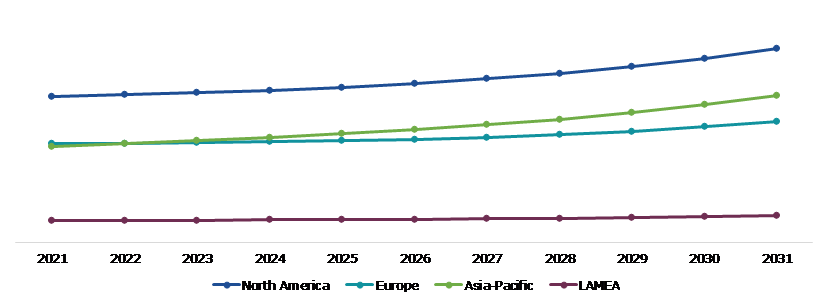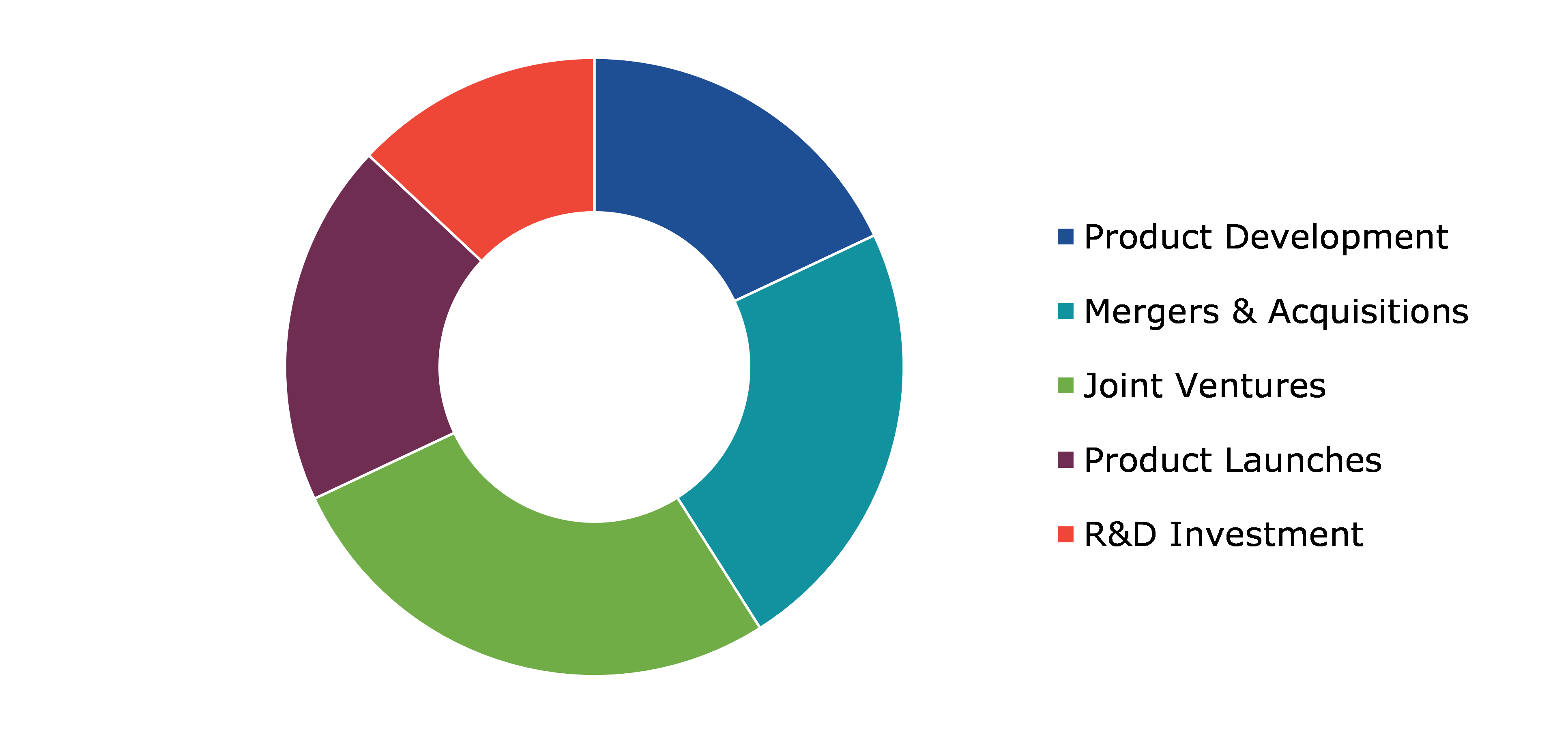Pole Vault Equipment Market Report
RA08677
Pole Vault Equipment Market by Product Type (Pole Vault Mat, Vault Box, Cross Bars, Height Gauge, Pole Vault Uprights, Accessories, and Others), Buyer Type (Individual, Promotional, and Institutional), Sales Channel (Sports Variety Stores, Direct to Customer Channel, Third Party, Online Channel, and Other Channels), and Region (North America, Europe, Asia-Pacific, and LAMEA): Global Opportunity Analysis and Industry Forecast, 2022-2031
Global Pole Vault Equipment Market Analysis
The Global Pole Vault Equipment Market Size was $1,11,961.0 thousand in 2021 and is predicted to grow with a CAGR of 3.2%, by generating a revenue of $1,50,766.1 thousand by 2031.
Global Pole Vault Equipment Market Synopsis
The popularity of pole vaulting has significantly increased in recent years. Pole vaulting is a difficult and thrilling sport that calls for a high level of skill, strength, and coordination, which is one of the reasons for the growth of the pole vault equipment market. Pole vaulting is a sport that is growing in popularity and interest. The demand for high-quality, safe, dependable, and effective pole-vaulting equipment has therefore increased. As more people take up the sport, the demand for pole vault equipment will increase.
However, pole vault equipment, particularly the poles themselves, can be quite fragile and prone to damage. This can be a problem for athletes who need to travel with their equipment or who use it frequently in practice and competition. Durability is an important consideration when it comes to pole vault equipment. The equipment needs to be able to withstand the strains of regular use, as well as exposure to natural elements, such as sun, wind, rain, and temperature changes.
The market for pole vaulting equipment has the potential to develop as pole vaulting's popularity improves. This is because more people who participate in the activity will need various equipment to enhance their performance and assure their safety during practice and competition. Equipment needed for pole vaulting includes poles, landing pads, spikes, and protective clothing. The demand for these kinds of equipment will rise along with the number of people engaging in the activity. Additionally, new prospects for market expansion may arise as a result of technological and material breakthroughs in the production of pole-vaulting equipment. Due to the sport's continued global development in popularity, there may potentially be prospects for market expansion through international expansion. This would make it possible for sellers and makers of pole-vaulting equipment to tap into new markets and connect with more people.
According to regional analysis, the pole vault equipment market share in the Asia-Pacific region is expanding rapidly in nations like China, India, Japan, South Korea, and Australia, among others. The rising interest in pole vaulting as a sport, the rising investment in athletic infrastructure, and the expansion of e-commerce channels are some of the factors driving the market.
Pole Vault Equipment Overview
The pole vault equipment market is a global market that encompasses the production, distribution, and sale of various pole-vaulting tools and accessories. This includes landing mats, plant boxes, standards, crossbars, and other related accessories. Poles made of materials like carbon fiber or fiberglass are also included. The pole vault equipment market serves both professional and amateur athletes, coaches, schools, and sports organizations. The market for pole vault equipment has grown recently due to factors including the rising popularity of pole vaulting as a sport and the rising popularity of athletic training and fitness.
COVID-19 Impact on Global Pole Vault Equipment Market
The COVID-19 impact on pole vault equipment market had a negative impact on the global pole vault equipment market. The lockdowns and restrictions on public gatherings and sports events led to the cancellation or postponement of many sporting events, including pole vaulting competitions. This has significantly reduced the demand for pole vault equipment, as athletes and sports clubs have been unable to participate in the sport. Additionally, the pandemic has hampered international supply chains, which has caused shortages and hold-ups in the manufacturing and delivery of pole vault equipment. Higher prices and lengthier client wait times have lowered the demand for equipment even more. Because of the economic impact of the pandemic, sports groups and schools now have lesser resources, making it more difficult for them to obtain high-quality pole vault equipment. The need for pole vault equipment is anticipated to gradually rise as the world starts to recover from the pandemic and restrictions are lifted. The return of sporting events and the rising recognition of pole vaulting as a sport will probably increase demand for gear. Furthermore, the market is anticipated to grow as a result of technological developments and the creation of new materials making pole vault equipment more accessible and affordable.
Growing Demand of Pole Vault Equipment in Sports Sector to Drive the Market Growth
The growing demand for pole vault equipment in the sports sector is a significant driver of market growth. As the sport of pole vaulting continues to gain popularity among athletes and enthusiasts around the world, there is a corresponding increase in the demand for high-quality pole vault equipment. This includes not only pole vault poles and landing mats, but also other equipment such as vault boxes, crossbars, and standards. Manufacturers of pole vault equipment are responding to this demand by developing new and innovative products that offer improved performance and safety. Younger generations are more prone to this trend since they are more likely to participate in physical activity and sports. Pole vaulting is a sport that requires a high level of strength, agility, and coordination, making it an excellent choice for athletes looking to improve their overall fitness and athleticism. As a result, there has been growing interest in pole vaulting as a training tool for athletes in other sports, such as track and field, gymnastics, and basketball.
To know more about global pole vault equipment market drivers, get in touch with our analysts here.
High Cost of Pole Vault Equipment to Restrain the Market Growth
Pole vault equipment has been expensive, especially for high-end equipment made from advanced materials such as carbon fiber. This can make it difficult for athletes, schools, and sports clubs with limited budgets to invest in high-quality equipment. Poles, landing mats, and other pole-vaulting equipment may be quite pricey, particularly if they are of high caliber and durability. This price may act as a barrier for some athletes, schools, and sports organizations who may lack the resources to buy the necessary equipment.
Sponsorship and Endorsements have to Drive Excellent Opportunities in the Market
The involvement of major sports brands in pole vaulting has led to increased exposure for the sport and has helped to create a market for specialized pole vault equipment. Sponsorship and endorsements have also helped to increase the popularity of the sport among younger generations. Sponsorship and endorsements can also help to create a sense of prestige and quality around certain brands of pole vault equipment. Athletes and sports teams that are sponsored by a particular brand of equipment can help to promote that brand and create a loyal customer base that seeks out that brand for their equipment needs. The pole vault equipment industry is expanding in part due to sponsorship and endorsements. In order to promote the sport and the gear used in it, many sports brands and corporations fund athletes, sports teams, and tournaments. For pole vaulting, sponsorship and endorsements from well-known sports companies have contributed to the sport's increased visibility and the emergence of a market for specialized pole vault gear. Leading sports companies like Nike, Adidas, Puma, and Asics have sponsored elite pole vaulters and given them specialized gear including poles, landing mats, and clothing.
To know more about global pole vault equipment market opportunities, get in touch with our analysts here.
Global Pole Vault Equipment Market, by Product Type
By product type, the market has been divided into pole vault mat, vault box, cross bars, height gauge, pole vault uprights, accessories, and others. Among these, the pole vault mat sub-segment accounted for the highest market share in 2021 and it is estimated to show the fastest growth during the forecast period.
Global Pole Vault Equipment Market Share, by Product Type, 2021
Source: Research Dive Analysis
The pole vault mat sub-type is had a dominant market share in 2021 and it is estimated to show the fastest growth during the forecast period. The pole vault landing mat is an important piece of equipment that helps absorb the shock of the athlete's landing and reduces the risk of injury. One driver of the pole vault landing mat market is the ongoing demand for increased safety in the sport of pole vaulting. The sale of pole vault landing mats is driven by the need for increased safety and performance in the sport of pole vaulting, as well as the growing popularity of the sport among athletes and enthusiasts.
Global Pole Vault Equipment Market, by Buyer Type
Based on buyer type, the market has been divided into individual, promotional, and institutional. Among these, the institutional sub-segment accounted for highest revenue share in 2021.
Global Pole Vault Equipment Market Size, by Buyer Type, 2021
Source: Research Dive Analysis
The institutional sub-segment had a dominant market share in 2021. The institutional segment of the pole vault equipment market growth refers to the use of pole vault equipment in educational institutions such as schools, colleges, and universities. This segment is a significant driver of growth in the overall market, as institutions invest in high-quality pole vault equipment to support their athletic programs and provide safe and effective training environments for their athletes. Many educational institutions are placing a greater emphasis on athletics and sports programs, as they recognize the importance of physical activity and fitness for overall student health and well-being. As a result, there is growing demand for high-quality pole vault equipment that can support these programs and help athletes achieve their full potential.
Global Pole Vault Equipment Market, by Sales Channel
Based on sales channel, the market has been divided into sports variety stores, direct to customer channel, third party online channel, and other channels. Among these, the direct to customer channel sub-segment accounted for highest revenue share in 2021.
Global Pole Vault Equipment Market Analysis, by Sales Channel, 2021
Source: Research Dive Analysis
The direct to customer channel sub-segment had a dominant market share in 2021. The direct to customer channel sub-segment of the pole vault equipment market refers to the sales and distribution of pole vault equipment directly to individual customers through online channels, without the involvement of intermediaries such as retailers or wholesalers. Customers conveniently purchase pole vault equipment through D2C channels without having to leave their houses and without having to go to a real store. Customers who reside in regions with restricted access to specialized sports equipment may find this to be especially advantageous.
Global Pole Vault Equipment Market, Regional Insights
The pole vault equipment market was investigated across North America, Europe, Asia-Pacific, and LAMEA.
Global Pole Vault Equipment Market Size & Forecast, by Region, 2021-2031 (USD Thousand)
Source: Research Dive Analysis
The Market for Pole Vault Equipment in North American was the Most Dominant
The North America pole vault equipment market accounted a dominating market share in 2021. The North American pole vault equipment market growth is a significant and mature market that includes the United States, Canada, and Mexico. The market is driven by several factors, including the popularity of pole vaulting as a sport, the high level of investment in athletic facilities, and the presence of established manufacturers and suppliers. A significant portion of the marketplace demand for pole vault equipment in the North American region is accounted for by the US. This could be ascribed to both the growing prevalence of pole vaulting at the secondary school level and the vast number of colleges and institutions with well-established athletic programmers. Furthermore, there is a significant manufacturing base for pole vault equipment market demand in the United States, where a number of well-known businesses provide excellent machinery for both home and foreign markets. Considering the rising popularity of the sport and the rising investment in sports facilities, Canada is another important market for pole vault equipment. Pole vaulting and other sports are supported by several new or updated athletic facilities that have been developed in Canada, a nation with a strong history of athletics.
Competitive Scenario in the Global Pole Vault Equipment Market
Investment and agreement are common strategies followed by major market players. For instance, in March 2020, [ESSX], a leading manufacturer of pole vault equipment, announced the launch of its newest product: the [bamboo to glass fiber reinforced polymer (GFRP)] pole vault pole.
Source: Research Dive Analysis
Some of the leading pole vault equipment market analysis players are Gill Athletics, BSN Sports LLC, aluminum athletic equipment co, Nordic Sport AB, United Canvas & Sling Incorporated, Altius Poles, Dimasport SA, Blazer Athletic Equipment, A.R.H Sports Equipment Ltd, and ESSX.
| Aspect | Particulars |
| Historical Market Estimations | 2020 |
| Base Year for Market Estimation | 2021 |
| Forecast Timeline for Market Projection | 2022-2031 |
| Geographical Scope | North America, Europe, Asia-Pacific, LAMEA |
| Segmentation by Product Type |
|
| Segmentation by Buyer Type |
|
| Segmentation by Sales Channel
|
|
| Key Companies Profiled |
|
Q1. What is the size of the global pole vault equipment market?
A. The size of the global pole vault equipment market size was over $1,11,961.0 thousand in 2021 and is projected to reach $1,50,766.1.1 thousand by 2031.
Q2. Which are the major companies in the pole vault equipment market?
A. Gill Athletics, BSN Sports LLC, and aluminum athletic equipment co, are some of the key players in the global pole vault equipment market.
Q3. Which region, among others, possesses greater investment opportunities in the near future?
A. The North America region possesses great investment opportunities for investors to witness the most promising growth in the future.
Q4. What will be the growth rate of the Asia-Pacific pole vault equipment market?
A. Asia-Pacific pole vault equipment market share is anticipated to grow at 4.5% CAGR during the forecast period.
Q5. What are the strategies opted by the leading players in this market?
A. Agreement and investment are the two key strategies opted by the operating companies in this market.
Q6. Which companies are investing more on R&D practices?
A. Gill Athletics, BSN Sports LLC, and aluminum athletic equipment co. are the companies investing more on R&D activities for developing new products and technologies.
1.Research Methodology
1.1.Desk Research
1.2.Real time insights and validation
1.3.Forecast model
1.4.Assumptions and forecast parameters
1.5.Market size estimation
1.5.1.Top-down approach
1.5.2.Bottom-up approach
2.Report Scope
2.1.Market definition
2.2.Key objectives of the study
2.3.Report overview
2.4.Market segmentation
2.5.Overview of the impact of COVID-19 on Global pole vault equipment market
3.Executive Summary
4.Market Overview
4.1.Introduction
4.2.Growth impact forces
4.2.1.Drivers
4.2.2.Restraints
4.2.3.Opportunities
4.3.Market value chain analysis
4.3.1.List of raw material suppliers
4.3.2.List of manufacturers
4.3.3.List of distributors
4.4.Innovation & sustainability matrices
4.4.1.Technology matrix
4.4.2.Regulatory matrix
4.5.Porter’s five forces analysis
4.5.1.Bargaining power of suppliers
4.5.2.Bargaining power of consumers
4.5.3.Threat of substitutes
4.5.4.Threat of new entrants
4.5.5.Competitive rivalry intensity
4.6.PESTLE analysis
4.6.1.Political
4.6.2.Economical
4.6.3.Social
4.6.4.Technological
4.6.5.Environmental
4.7.Impact of COVID-19 on pole vault equipment market
4.7.1.Pre-covid market scenario
4.7.2.Post-covid market scenario
5.Pole Vault Equipment Market Analysis, by Product Type
5.1.Overview
5.2.Pole Vault Mat
5.2.1.Definition, key trends, growth factors, and opportunities
5.2.2.Market size analysis, by region, 2021-2031
5.2.3.Market share analysis, by country, 2021-2031
5.3.Vault Box
5.3.1.Definition, key trends, growth factors, and opportunities
5.3.2.Market size analysis, by region, 2021-2031
5.3.3.Market share analysis, by country,2021-2031
5.4.Cross Bars
5.4.1.Definition, key trends, growth factors, and opportunities
5.4.2.Market size analysis, by region, 2021-2031
5.4.3.Market share analysis, by country, 2021-2031
5.5.Height Gauge
5.5.1.Definition, key trends, growth factors, and opportunities
5.5.2.Market size analysis, by region, 2021-2031
5.5.3.Market share analysis, by country, 2021-2031
5.6.Pole Vault Uprights
5.6.1.Definition, key trends, growth factors, and opportunities
5.6.2.Market size analysis, by region, 2021-2031
5.6.3.Market share analysis, by country, 2021-2031
5.7.Accessories
5.7.1.Definition, key trends, growth factors, and opportunities
5.7.2.Market size analysis, by region, 2021-2031
5.7.3.Market share analysis, by country, 2021-2031
5.8.Others
5.8.1.Definition, key trends, growth factors, and opportunities
5.8.2.Market size analysis, by region, 2021-2031
5.8.3.Market share analysis, by country, 2021-2031
5.9.Research Dive Exclusive Insights
5.9.1.Market attractiveness
5.9.2.Competition heatmap
6.Pole Vault Equipment Market Analysis, by Buyer Type
6.1.Individual
6.1.1.Definition, key trends, growth factors, and opportunities
6.1.2.Market size analysis, by region, 2021-2031
6.1.3.Market share analysis, by country, 2021-2031
6.2.Promotional
6.2.1.Definition, key trends, growth factors, and opportunities
6.2.2.Market size analysis, by region,2021-2031
6.2.3.Market share analysis, by country,2021-2031
6.3.Institutional
6.3.1.Definition, key trends, growth factors, and opportunities
6.3.2.Market size analysis, by region, 2021-2031
6.3.3.Market share analysis, by country,2021-2031
6.4.Research Dive Exclusive Insights
6.4.1.Market attractiveness
6.4.2.Competition heatmap
7.Pole Vault Equipment Market Analysis, by Sales Channel
7.1.Sports Variety Stores
7.1.1.Definition, key trends, growth factors, and opportunities
7.1.2.Market size analysis, by region, 2021-2031
7.1.3.Market share analysis, by country, 2021-2031
7.2.Direct to Customer Channel
7.2.1.Definition, key trends, growth factors, and opportunities
7.2.2.Market size analysis, by region, 2021-2031
7.2.3.Market share analysis, by country, 2021-2031
7.3.Third Party Online Channel
7.3.1.Definition, key trends, growth factors, and opportunities
7.3.2.Market size analysis, by region, 2021-2031
7.3.3.Market share analysis, by country, 2021-2031
7.4.Other Channels
7.4.1.Definition, key trends, growth factors, and opportunities
7.4.2.Market size analysis, by region,2021-2031
7.4.3.Market share analysis, by country,2021-2031
7.5.Research Dive Exclusive Insights
7.5.1.Market attractiveness
7.5.2.Competition heatmap
8.Pole Vault Equipment Market, by Region8.1.North America
8.1.1.U.S.
8.1.1.1.Market size analysis, by Product Type, 2021-2031
8.1.1.2.Market size analysis, by Buyer Type,2021-2031
8.1.1.3.Market size analysis, by Sales Channel,2021-2031
8.1.2.Canada
8.1.2.1.Market size analysis, by Product Type, 2021-2031
8.1.2.2.Market size analysis, by Buyer Type,2021-2031
8.1.2.3.Market size analysis, by Sales Channel,2021-2031
8.1.3.Mexico
8.1.3.1.Market size analysis, by Product Type, 2021-2031
8.1.3.2.Market size analysis, by Buyer Type,2021-2031
8.1.3.3.Market size analysis, by Sales Channel,2021-2031
8.1.4.Research Dive Exclusive Insights
8.1.4.1.Market attractiveness
8.1.4.2.Competition heatmap
8.2.Europe
8.2.1.Germany
8.2.1.1.Market size analysis, by Product Type, 2021-2031
8.2.1.2.Market size analysis, by Buyer Type,2021-2031
8.2.1.3.Market size analysis, by Sales Channel,2021-2031
8.2.2.UK
8.2.2.1.Market size analysis, by Product Type, 2021-2031
8.2.2.2.Market size analysis, by Buyer Type,2021-2031
8.2.2.3.Market size analysis, by Sales Channel,2021-2031
8.2.3.France
8.2.3.1.Market size analysis, by Product Type, 2021-2031
8.2.3.2.Market size analysis, by Buyer Type,2021-2031
8.2.3.3.Market size analysis, by Sales Channel,2021-2031
8.2.4.Spain
8.2.4.1.Market size analysis, by Product Type, 2021-2031
8.2.4.2.Market size analysis, by Buyer Type,2021-2031
8.2.4.3.Market size analysis, by Sales Channel,2021-2031
8.2.5.Italy
8.2.5.1.Market size analysis, by Product Type, 2021-2031
8.2.5.2.Market size analysis, by Buyer Type,2021-2031
8.2.5.3.Market size analysis, by Sales Channel,2021-2031
8.2.6.Rest of Europe
8.2.6.1.Market size analysis, by Product Type, 2021-2031
8.2.6.2.Market size analysis, by Buyer Type,2021-2031
8.2.6.3.Market size analysis, by Sales Channel,2021-2031
8.2.7.Research Dive Exclusive Insights
8.2.7.1.Market attractiveness
8.2.7.2.Competition heatmap
8.3.Asia Pacific
8.3.1.China
8.3.1.1.Market size analysis, by Product Type, 2021-2031
8.3.1.2.Market size analysis, by Buyer Type,2021-2031
8.3.1.3.Market size analysis, by Sales Channel,2021-2031
8.3.2.Japan
8.3.2.1.Market size analysis, by Product Type, 2021-2031
8.3.2.2.Market size analysis, by Buyer Type,2021-2031
8.3.2.3.Market size analysis, by Sales Channel,2021-2031
8.3.3.India
8.3.3.1.Market size analysis, by Product Type, 2021-2031
8.3.3.2.Market size analysis, by Buyer Type,2021-2031
8.3.3.3.Market size analysis, by Sales Channel,2021-2031
8.3.4.Australia
8.3.4.1.Market size analysis, by Product Type, 2021-2031
8.3.4.2.Market size analysis, by Buyer Type,2021-2031
8.3.4.3.Market size analysis, by Sales Channel,2021-2031
8.3.5.South Korea
8.3.5.1.Market size analysis, by Product Type, 2021-2031
8.3.5.2.Market size analysis, by Buyer Type,2021-2031
8.3.5.3.Market size analysis, by Sales Channel,2021-2031
8.3.6.Rest of Asia Pacific
8.3.6.1.Market size analysis, by Product Type, 2021-2031
8.3.6.2.Market size analysis, by Buyer Type,2021-2031
8.3.6.3.Market size analysis, by Sales Channel,2021-2031
8.3.7.Research Dive Exclusive Insights
8.3.7.1.Market attractiveness
8.3.7.2.Competition heatmap
8.4.LAMEA
8.4.1.Brazil
8.4.1.1.Market size analysis, by Product Type, 2021-2031
8.4.1.2.Market size analysis, by Buyer Type,2021-2031
8.4.1.3.Market size analysis, by Sales Channel,2021-2031
8.4.2.Saudi Arabia
8.4.2.1.Market size analysis, by Product Type, 2021-2031
8.4.2.2.Market size analysis, by Buyer Type,2021-2031
8.4.2.3.Market size analysis, by Sales Channel,2021-2031
8.4.3.UAE
8.4.3.1.Market size analysis, by Product Type, 2021-2031
8.4.3.2.Market size analysis, by Buyer Type,2021-2031
8.4.3.3.Market size analysis, by Sales Channel,2021-2031
8.4.4.South Africa
8.4.4.1.Market size analysis, by Product Type, 2021-2031
8.4.4.2.Market size analysis, by Buyer Type,2021-2031
8.4.4.3.Market size analysis, by Sales Channel,2021-2031
8.4.5.Rest of LAMEA
8.4.5.1.Market size analysis, by Product Type, 2021-2031
8.4.5.2.Market size analysis, by Buyer Type,2021-2031
8.4.5.3.Market size analysis, by Sales Channel,2021-2031
8.4.6.Research Dive Exclusive Insights
8.4.6.1.Market attractiveness
8.4.6.2.Competition heatmap
9.Competitive Landscape
9.1.Top winning strategies, 2021
9.1.1.By strategy
9.1.2.By year
9.2.Strategic overview
9.3.Market share analysis, 2021
10.Company Profiles
10.1.Gill Athletics
10.1.1.Overview
10.1.2.Business segments
10.1.3.Product portfolio
10.1.4.Financial performance
10.1.5.Recent developments
10.1.6.SWOT analysis
10.2.BSN Sports LLC
10.2.1.Overview
10.2.2.Business segments
10.2.3.Product portfolio
10.2.4.Financial performance
10.2.5.Recent developments
10.2.6.SWOT analysis
10.3.aluminum athletic equipment co.
10.3.1.Overview
10.3.2.Business segments
10.3.3.Product portfolio
10.3.4.Financial performance
10.3.5.Recent developments
10.3.6.SWOT analysis
10.4.Nordic Sport AB
10.4.1.Overview
10.4.2.Business segments
10.4.3.Product portfolio
10.4.4.Financial performance
10.4.5.Recent developments
10.4.6.SWOT analysis
10.5.United Canvas & Sling Incorporated
10.5.1.Overview
10.5.2.Business segments
10.5.3.Product portfolio
10.5.4.Financial performance
10.5.5.Recent developments
10.5.6.SWOT analysis
10.6.Altius Poles.
10.6.1.Overview
10.6.2.Business segments
10.6.3.Product portfolio
10.6.4.Financial performance
10.6.5.Recent developments
10.6.6.SWOT analysis
10.7.Dimasport SA.
10.7.1.Overview
10.7.2.Business segments
10.7.3.Product portfolio
10.7.4.Financial performance
10.7.5.Recent developments
10.7.6.SWOT analysis
10.8.Blazer Athletic Equipment.
10.8.1.Overview
10.8.2.Business segments
10.8.3.Product portfolio
10.8.4.Financial performance
10.8.5.Recent developments
10.8.6.SWOT analysis
10.9.A.R.H Sports Equipment Ltd.
10.9.1.Overview
10.9.2.Business segments
10.9.3.Product portfolio
10.9.4.Financial performance
10.9.5.Recent developments
10.9.6.SWOT analysis
10.10.ESSX
10.10.1.Overview
10.10.2.Business segments
10.10.3.Product portfolio
10.10.4.Financial performance
10.10.5.Recent developments
10.10.6.SWOT analysis
Many people all over the world enjoy playing sports games, which include a variety of activities and competitions. One sport that has grown in popularity over the years is pole vaulting. But it is crucial to remember that pole vaulting may be a risky sport. This is where the pole vault equipment solution comes in.
The pole vault equipment market is a global industry that includes the manufacturing, distribution, and sale of numerous pole vaulting accessories and tools. Pole vaulting is a track and field event during which athletes use a long and flexible pole to clear a bar at a specific height. The sport needs specialized equipment for safety and proper performance. This includes plant boxes, landing mats, crossbars, standards, and other related accessories. Additionally, there are poles constructed of fiberglass and carbon fiber.
Recent Trends in the Pole Vault Equipment Market
The pole vault equipment market is continuously evolving with new advancements in technology and materials. The increasing popularity of e-commerce has had a considerable impact on the pole vault equipment market. Coaches and athletes now have easy access to a broad choice of equipment from numerous manufacturers via internet platforms. This has boosted competition and made it simpler for customers to compare pricing, features, and reviews prior to making a purchase.
In addition, manufacturers have focused on developing pole vaulting equipment with improved safety features because safety is a key component of the sport. For instance, some pole vault tools now feature integrated vibration dampening technologies to lower the possibility of injury and give athletes a more stable experience. Landing mats and safety pads have also been updated to decrease the impact on athletes during landings.
Newest Insights in the Pole Vault Equipment Market
As per a report by Research Dive, the global pole vault equipment market is expected to grow at a CAGR of 3.2% and generate revenue of $1,50,766.1 thousand by 2031. The primary factors driving the growth of the market are the increasing need for innovative products that offer enhanced performance and safety, rising sponsorship and endorsement levels, and the growing need for pole vault equipment in the sports industry. However, the high cost of pole vault equipment is expected to hinder the market growth.
The pole vault equipment market in North America is expected to remain dominant in the coming years. The region's high revenue in 2021 was driven by the increasing popularity of pole vaulting at the secondary school level as well as the vast number of colleges and other educational institutions with strong sporting programmes. This has led to an increased demand for high-quality pole vault equipment to support the growing demand.
How are Market Players Responding to the Rising Demand for Pole Vault Equipment?
Market players are responding to the rising demand for pole vault equipment by investing in research and development to create more innovative and advanced equipment. They are also boosting their production capacity while exploring new markets to meet the growing demand.
In addition, market players are increasingly focusing on strategic partnerships and collaborations with other players in the industry to leverage their strengths and expand their reach. Some of the foremost players in the pole vault equipment market are Aluminium Athletic Equipment Co., Gill Athletics, United Canvas & Sling Incorporated, Nordic Sport AB, Altius Poles, Dimasport SA, BSN Sports LLC, Blazer Athletic Equipment, ESSX, A.R.H. Sports Equipment Ltd., and others. These players are focused on implementing strategies such as mergers and acquisitions, novel developments, collaborations, and partnerships to reach a leading position in the global pole vault equipment market.
For instance, in May 2022, Armand Duplantis, the world record-holder, made an unexceptional start to his outdoor game series by winning the men’s pole vault with a vault of 5.91m at the Eugene Diamond League.
COVID-19 Impact on the Global Pole Vault Equipment Market
The COVID-19 pandemic had an adverse impact on the global pole vault equipment market. Numerous sporting activities, including pole vaulting competitions, were cancelled or delayed as a result of lockdowns and limitations on gatherings of the public and sporting events. As a result, individuals and sports teams were unable to participate in the sport, which dramatically decreased the need for pole vault equipment. The pandemic also hindered global supply networks, which led to shortages and delays in the production and delivery of pole vault equipment. The need for equipment was further decreased by higher pricing and longer client wait times. Additionally, sports teams and schools had less funding as a result of the pandemic's economic effects, which made it more challenging for them to acquire high-quality pole vault equipment. However, as the world recovers from the pandemic and restrictions are relaxed, the demand for pole vault equipment is expected to progressively increase in the coming years.
Personalize this research
- Triangulate with your own data
- Request your format and definition
- Get a deeper dive on a specific application, geography, customer or competitor
- + 1-888-961-4454 Toll - Free
- support@researchdive.com

